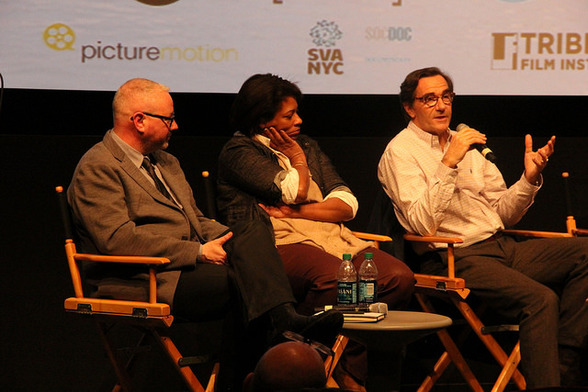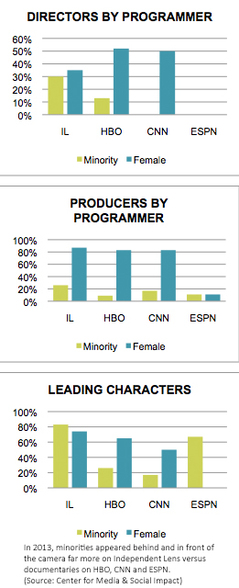
POV executive producer Simon Kilmurry, filmmaker Dawn Porter and WNET VP for programming Stephen Segaller at PBS’ New York listening tour (POV Docs)
The scene was New York’s SVA Theater in Chelsea and the battle was over a proposal to shift two beloved PBS documentary programs to a secondary station.
Mikel Ellcessor, moderator for the day, tried his best to hold them back, but the documentary makers would not be stopped from airing their frustrations in a clash that demonstrates the dilemma for PBS and its affiliates between keeping both its struggling arts and documentary programs afloat.
Fearing the sidelining of documentary mainstays POV and Independent Lens, more than 400 people—mostly filmmakers—turned up at the town hall meeting on Monday, and 20 took turns on the mike.
“I feel a sense of devaluation,” said Byron Hurt, director of Hip-Hop: Beyond Beats and Rhymes. “And a lack of respect for independent filmmakers.”
At stake are two flagship independent documentary programs. Both offer unique creative freedom to filmmakers: final editorial control and retention of copyright, although filmmakers raise the money to make the films themselves. Both frequently show under-covered films by and featuring people of color; POV has run since 1988, and its latest series includes Out in the Night, about a group of African-American lesbians. And their documentaries consistently win plaudits, racking up 42 Emmys between them, as well as several Oscars, Peabody awards, and DuPont awards.
 “POV and Independent Lens are so prestigious within my community,” said Liz Garbus, whose Street Fight aired on POV. “If you take away their reach and their audience, we’re not going to bring the same programs to you.”
“POV and Independent Lens are so prestigious within my community,” said Liz Garbus, whose Street Fight aired on POV. “If you take away their reach and their audience, we’re not going to bring the same programs to you.”
Last December, WNET, New York’s PBS affiliate and the nation’s most-watched public broadcasting station, decided to move the two shows to WLIW, a secondary PBS station that can be found in as many households as WNET but is less prestigious. They would play at their regular timeslot, Mondays at 10pm, while reruns of arts programs like Great Performances and American Masters would replace them on WNET. WNET would re-run the documentary shows on Sundays at 11pm.
Filmmakers were incensed. PBS put the brakes on its scheduling change until May. Meanwhile, the broadcaster embarked on a nationwide “listening tour” that has also visited San Francisco, with Chicago to follow.
New York, home to many of the filmmakers, was the second stop. Nearly 40 minutes in, the energetic Ellcessor, a media consultant and former public radio director, tried to steer questions to other topics—the “listening tour” was originally intended to introduce new PBS VP of news and public affairs Marie Nelson to the public. Those onstage included Nelson; Beth Hoppe, chief programming executive for PBS; and Stephen Segaller, vice president for programming at WNET.
But the impassioned crowd only wanted to discuss one thing. The filmmakers want POV and Independent Lens to retain their prime time slot on PBS’ premier channel. They also want “common carriage”—where nationwide PBS member stations are mandated to air the program simultaneously. Currently, only 20 of the 50 top PBS stations do so, according to Segaller.
Hoppe said that PBS wanted to step up digital distribution and promotions for the documentaries. Segaller, himself a documentary maker, said showing the programs twice instead of once per week was an experiment to grow their audience. “We were increasing the access to the programming, not diminishing it,” he said.
The issue put WNET in a bind. High quality arts programs and independent documentaries–along with children’s TV programs like Sesame Street–are at the core of PBS’ mission, and what separates it from commercial television. But both consistently perform poorly in ratings. WNET loses as many as 80 percent of its viewers between Antiques Roadshow and Monday’s documentary programs.
“Of course, one of the great virtues of public television is that we’re not only concerned about ratings,” Segaller said in an interview. “But we are concerned about impact, and we are concerned about reach, and ratings is one of the ways you measure [those].”
Meanwhile, the lion’s share of donations to WNET are specifically for arts programs, which WNET produces itself.
That arts programming “is really one of the engines that drives this company as a business,” Segaller said. “And therefore it does have a somewhat different status and priority in our concerns.”
Even in an on-demand Netflix age, shuffling TV schedules acutely affect the viewers that PBS targets. PBS is the nation’s fifth largest network, and runs without cable subscriptions, making it accessible to lower income families. POV and Independent Lens, with their focus on the stories of minorities and the economically disadvantaged, benefit from airing on public television. Indeed, POV executive producer Simon Kilmurry said that 80 percent of viewing on PBS is done at the time of broadcast. Though they air on PBS’ website, few of the documentaries make it to streaming powerhouses Netflix or Amazon Prime: a study from the Center for Media & Social Impact showed that 43 percent of POV and Independent Lens films were not picked up by either service between 2012 and 2014.*
A high profile timeslot also means greater clout. A prime time airing on a leading channel means publicity from The New York Times and greater funding. Conversely, filmmakers say that if the nation-leading WNET bumps POV and Independent Lens to a secondary channel, that signals to other PBS stations that these shows are less important.
To filmmaker Whitney Dow, director of Two Towns of Jasper, the scheduling issue is symptomatic of an identity crisis at PBS. “I feel like PBS has in some ways abdicated their mandate by focusing on these big British projects,” he said after the town hall, referring to popular period drama Downton Abbey among others. “I think that they don’t really have a clear vision about how to incorporate independent film into their overall brand.”
*An earlier version of this story said that 43 percent of POV and Independent Lens films ran on Netflix or Amazon Prime between 2012 and 2014 and omitted that they run on PBS.org.
Chris Ip is a CJR Delacorte Fellow. Follow him on Twitter at @chrisiptw.
